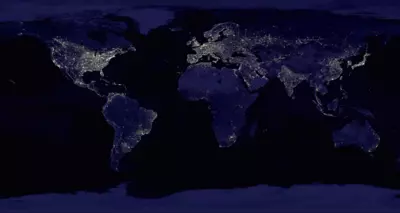Initial Publication Date: May 13, 2020
Mapping Light Pollution in Your Community
Introduction
Global view of Earth at night. Image courtesy of NASA. Click image for larger view.
Many people in the world have never seen the Milky Way sweeping across the sky. In fact, most of us are able to see only a dozen or so of the brightest stars in the sky and don't realize there are about 6,000 stars visible to the naked eye. The ongoing loss of a dark night sky for much of the world's population is a growing, serious issue that impacts not only astronomical research, but also human health, ecology and ecosystems, safety and security, and energy conservation. Up to $10 billion dollars is wasted each year in the United States by lighting up the underbellies of birds and clouds. According to the United Nations, 2008 will be the first year in which 3.3 billion people (over half of the world's population) will live in cities. With the growth of large cities in Africa and Asia, the number of people living in cities could climb to 5 billion by 2030. And, as cities grow, so does their impact on the global environment.
Light pollution has a negative influence on a variety of animals and plants in a variety of ways. It has been shown to disorient animals. Light pollution affects mating, alters predator-prey behavior, confuses migration, and influences animal physiology. Effects have been observed over a full range of taxonomic groups, including birds, reptiles, mammals, amphibians, fishes, invertebrates, and plants. In short, the dark sky is a natural resource that should be protected. In this activity, you will measure the light pollution in your community, look for what is causing the pollution, and construct a contour map in order to study this phenomenon.
What You'll Need
Before beginning your investigation, make sure you have:
- GIS software installed on your computer;
- Dark Sky Data Sheet (Microsoft Word 35kB Sep18 08);
- Orion Locator and Light Pollution Chart (Microsoft Word 1.6MB Sep18 08);
- Cygnus star map (Microsoft Word 1018kB Sep18 08) (for fall viewing);
- a GPS unit (optional); and
- a compass (optional)

